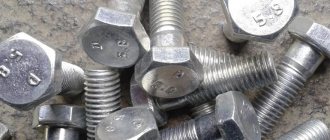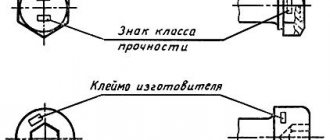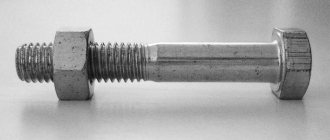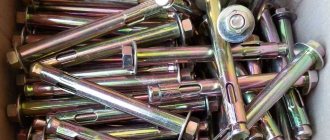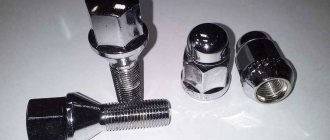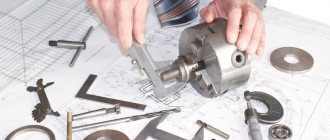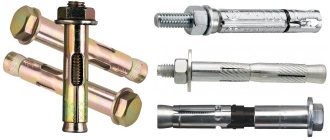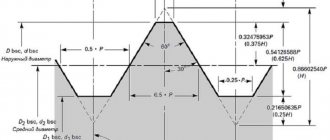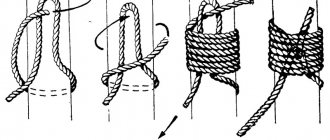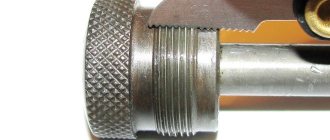GOST standards for bolt, nut, washer
GOSTs On this page you can view or download the texts of GOSTs for hardware, fasteners, as well as Technical conditions and control methods for a bolt, nut, flat washer, etc.
Bolts
- 7798-70 Hex head bolt, accuracy class B
- 7805-70 Hex head bolts, accuracy class A
- 10602-94 Hex head bolts with diameter over 48 mm
- 12459-67 Bolts reinforced for machined grooves
- Р52644-2006 High-strength bolts with hexagon head
- 22353-77 High-strength bolts (inactive since January 1, 2008, GOST R52644-2006 came into force)
- 24379.1-80 Foundation bolts (inactive, replaced by GOST 24379.1-2012 from 07/01/2013)
- 7801-81 Bolts with an enlarged semicircular head and a mustache
- 7802-81 Bolts with enlarged semicircular head and carriage
- 7808-70 Bolts with hexagonal reduced head
- 14724-69 Folding bolts
- 4751-73 Eye Bolt
- 28778-90 Self-anchoring expansion bolts
- 7817-80 Bolts with hexagonal reduced head for reamer holes
Screws
- 10336-80 Captive screws
- 10341-80 Captive screws with semicircular head
- 10621-80 Self-tapping screw with semicircular head
- 11074-93 Set screws with flat end and hexagonal socket
- 11075-93 Set screws with cylindrical end and hexagonal socket
- 11738-84 Hex socket head screws
- 12458-67 Shoulder screws
- 12463-67 Pressure screws with star-shaped handle
- 13428-68 Pressure screws with cylinder. the end for the camp. app..pdf
- 13429-68 Pressure screws with a heel end for mills. app..pdf
- 1476-93 Set screws with a tapered end and a straight slot
- 1477-93 Set screws with flat end and straight slot
- 1491-80 Pan head screw
- 17473-80 Round head screws
- 17474-80 Countersunk head screws
- 17475-80 Countersunk screws
- 8878-93 Set screws with tapered end and hexagonal socket
Nuts
- 10605-94 Hex nuts with a diameter over M48
- 11860-85 Cap nuts
- 11871-88 Round spline nuts
- 12460-67 Nuts with locking screw
- 12461-67 Nuts with trapezoidal thread, hexagonal, high
- 12462-67 Nuts with trapezoidal thread, hexagonal with shoulder
- 13426-68 Nuts with handle for machine tools
- 13427-68 Nuts with a hole for the handle for the machine. prisp.
- Р52645-2006 High-strength nuts
- 22354-77 High-strength nuts (cancelled from January 1, 2008)
- 2524-70 Hex nuts with reduced wrench size
- 3032-76 Wing nuts
- 5915-70 Hex nuts, accuracy class B
- 5916-70 Low hex nuts
- 5918-73 Hexagon slotted and castle nuts
- 5927-70 Hex nuts, accuracy class A
- 9064-75 Nuts for flange connections
Rivets
- 10299-80 Round head rivets
- 10299-80 Rivets
- 10300-80 Rivets with countersunk head
Retaining rings
- 13940-86 Spring thrust rings, flat, outer, concentric
- 13941-86 Spring thrust rings flat internal concentric
- 13942-86 Flat external eccentric spring thrust rings
- 13942-86 Flat external eccentric spring thrust rings
- 13943-86 Spring thrust rings flat internal eccentric
- 13943-86 Spring thrust rings flat internal eccentric
Washers
- 10450-78 Reduced washers
- 10462-81 Lock washers with internal teeth
- 10906-78 Oblique washers
- 11371-78 Flat washers
- 11648-75 Quick release thrust washers
- 11872-89 Multi-jaw lock washer
- 13439-68 Conical washers for machine tools
- 13463-77 Lock washers with tab and toe
- 13464-77 Reduced lock washers with claw
- 13943-86 Inner lock washer
- Р52646-2006 High-strength washers
- 22355-77 High-strength washers (cancelled from January 1, 2008)
- 3057-90 Disc springs
- 6402-70 Spring washers
- 6958-78 Enlarged washers
- 9065-75 Washer for flange connections
- 9065-75 Washers for flange connections
Hairpins
- 10494-80 Studs for flanges with lens seal
- 22034-76 Screw-in studs 1-25d
- 22041-76 Studs with screwed end 2-5d A
- 22040-76 Studs with screw-in end 2-5d B
- 22042-76 Studs for parts with smooth holes B
- 22043-76 Studs for parts with smooth holes A
- 9066-75 Studs for flange connections
Cotter pins
- 397-79 Cotter pins
Pins
- 3128-70 Cylindrical pins, unhardened
- 3129-70 Conical pins, non-hardened
- 9464-79 Conical pins with internal thread, unhardened
- 9465-79 Conical pins with threaded pin, unhardened
Screws
- 1144-80 Round head screws
- 1145-80 Countersunk head screws
- 1146-80 Screws with semi-countersunk head
- 11473-75 Hex head screws
Those. conditions and methods of control
- 13152-67 Machine tools
- 14724-69 Machine tools
- 1491-80 Screws design and dimensions
- 1759.0-87 Bolts screws studs nuts TU
- 1759.1-82 Bolts screws studs nuts screws Tolerances control methods
- 1759.2-82 Bolts screws studs Surface defects control methods
- 1759.3-83 Nuts surface defects control methods
- R52643-2006 Bolts, nuts, washers, high-strength TU
- 22356-77 Bolts, nuts, washers, high-strength specifications (cancelled from January 1, 2008)
- 23360-78 Connections keyed dimensions tolerances
- 24071-97 Segment keys, interchangeability standards
- 24379.0-80 Foundation bolts TU (inactive, replaced by GOST 24379.0-2012 from 07/01/2013)
- P50403-92 Countersunk head screws TU
- Р50404-92 Screws with a cylindrical rounded head with a straight slot TU
- P50405-92 Cylindrical head screws with straight slot TU
- P50406-92 Screws with semi-countersunk head TU
Main characteristics of nuts made of carbon and alloy steel (GOST 1759.5-87)
The table has been compiled to show the hardness of nuts with coarse threads. It is important that the lower limits of hardness are given only for nuts that have been heat treated, or there is no real opportunity to first test them by giving an experimental load. In all other cases, information about minimum hardness values is for reference only.
| Nominal thread diameter d, mm | Strength class | ||||||||||
| 04 | 05 | 4 | |||||||||
| Test load stress σF, MPa | Vickers hardness HV | Test load stress σF, MPa | Vickers hardness HV | Rockwell hardness HRSe | Test load stress σF, MPa | Vickers hardness HV | |||||
| no less | no more | no less | no more | no less | no more | no less | no more | ||||
| <4 | 380 | 188 | 302 | 500 | 272 | 353 | 27,8 | 36 | — | — | — |
| 4 -7 | |||||||||||
| 7- 10 | |||||||||||
| 10- 16 | |||||||||||
| 16-48 | 510 | 117 | 30 | ||||||||
| Nominal thread diameter d, mm | Strength class | ||||||||||
| 5 | 6 | 8 | |||||||||
| Test load stress σF, MPa | Vickers hardness HV | Test load stress σF MPa | Vickers hardness HV | Test load stress σF, MPa | Rockwell hardness NKSe | Vickers hardness HV | |||||
| no less | no more | no less | no more | no less | no more | no less | no more | ||||
| <4 | 520 | 130 | 302 | 600 | 150 | 302 | 800 | 170 | 302 | — | — |
| 4-7 | 580 | 670 | 810 | 188 | |||||||
| 7 — 10 | 590 | 680 | 830 | ||||||||
| 10 — 16 | 610 | 700 | 840 | ||||||||
| 16-48 | 630 | 146 | 720 | 170 | 920 | 233 | 353 | 38 | |||
| Nominal thread diameter d, mm | Strength class | ||||||||||||
| 9 | 10 | 12 | |||||||||||
| Test load voltage σF. MPa | Vickers hardness HV | Test load stress σF MPa | Vickers hardness HV | Rockwell hardness NKSe | Test load stress σF, MPa | Vickers hardness HV | Rockweal hardness NKSe | ||||||
| no less | no more | no less | no more | no less | no more | no less | no more | no less | no more | ||||
| < 4 | 900 | 170 | 302 | 1040 | 272 | 353 | 28 | 38 | 1150 | 295 | 353 | 31 | 38 |
| 4- 7 | 915 | 188 | 1040 | 1150 | |||||||||
| 7- 10 | 940 | 1040 | 1160 | ||||||||||
| 10- 16 | 950 | 1050 | 1190 | ||||||||||
| 16-48 | 920 | 1060 | 1200 | — | — | ||||||||
For nuts whose strength class corresponds to 0.4, 4, 5, 6 and 9, the minimum hardness indicators NKSe are not defined. The upper limit of hardness should not exceed HRC 30.
The strength classes of nuts with a height of 0.8d, designed for threads of at least 0.6d, are indicated by an indicator characterizing the maximum permissible strength class of bolts recommended for use with them, which corresponds to a hundredth of the experimental stress recorded during testing.
The strength classes of nuts, the height of which varies from 0.5 to 0.8d, designed for threads from 0.4 to 0.6d, are indicated by two numbers. The first indicates the maximum permissible ability of the nut in the joint with the bolt to withstand a load, which is less than the same indicator for a hardened mandrel and a nut whose height is greater than 0.8d.
GOST 1759.5-87 is approved to regulate the chemical characteristics and the most preferred steel grades used for the production of nuts.
ACCEPTANCE
3.1. Rules for acceptance of bolts, screws, studs and nuts - according to GOST 17769.
3.2. Each batch of fasteners must be accompanied by a quality document indicating:
name or trademark of the manufacturer;
symbol of the product;
list and results of tests performed;
net mass of the batch;
means of temporary anti-corrosion protection and protection period.
Notes: 1. It is allowed to place a document on the quality of products in a container or conveyor, and its safety during transportation must be ensured.
. Before 01/01/92, the mandatory tests were:
according to GOST 1759.4 for strength classes 8.8 - 12.9, determination of tensile strength and determination of impact strength; for strength classes 4.8; 5.8; 6.8 test for the strength of the connection between the head and the rod;
according to GOST 1759.5 for strength classes 8 - 12 test load test.
Other tests are carried out at the request of the consumer.
(Changed edition, Amendment No. 1).
Materials for the manufacture of fasteners
Although fastener elements are made not only from metals, but also from plastics, wood and other materials, the main interest is in fasteners made from various types of steels, non-ferrous metals and alloys. Due to the high cost of the latter, the bulk of the fasteners produced are made from various grades of steel. The selected material depends on the requirements for the mechanical and physical-chemical characteristics of fasteners and is determined by the table below:
| Fastener steel grade | tensile strength σв, MPa | yield strength σt, MPa | relative elongation σ5, % | impact strength, aH, J/cm2 | |
| Bolts | Nuts | no less | |||
| 12Х18Н10Т | 12Х18Н9Т, 10Х17Н13М2Т | 520 | 200 | 40 | 40 |
| 20Х13 | — | 700 | 550 | 15 | 60 |
| 14Х17Н2 | 20Х13, 14Х17Н2 | 650 | 12 | 60 | |
| 10Х11Н23Т3МР 13Х11Н2В2МФ | — Х12Н22Т3МР | 900 | 550 | 8 | 30 |
| 25Х1МФ | 25Х2М1Ф 20Х1М1Ф1ТР | 750 | 10 | 30 | |
The choice is determined by the requirements for corrosion resistance, temperature strength, ability to work under pressure, in aggressive environments, the presence or absence of certain magnetic properties, etc.
In a number of cases, when high demands are placed on fastening elements in terms of corrosion resistance, weight, strength, dimensions, high heat resistance, lack of spark upon impact, and many others, other metals and alloys are used for their manufacture. We are talking about brass, titanium, tantalum, beryllium alloys, aluminum, tungsten and others.
Protective coatings for fasteners
Fastening elements are additionally protected by creating oxide films (oxidation), as well as various types of coatings. The choice of coating is determined by technical requirements; the thickness depends on the size of the fastener and the thread pitch. In particular, for the most popular options:
- With a thread pitch P < 0.4 mm, the coating thickness varies in the range of 3-6 µm;
- With a thread pitch of 0.4 < P < 0.8 mm, the thickness is 6-9 µm;
- With a thread pitch of P > 0.8 mm, the coating thickness is 9-12 microns.
All necessary definitions are contained in GOST 1759.4-87. Coatings must meet the requirements specified in Table 2:
| Designation | Coating | Operating temperature, t °C, no more |
| 00 | Uncoated fasteners | |
| 01 | Chromated zinc plated fasteners | 300 |
| 02 | Cadmium plated with chromated fasteners | 200 |
| 03 | Multi-layer copper-nickel coating of fasteners | 600 |
| 04 | Multilayer copper-nickel-chrome | 600 |
| 05 | Oxide coating of fasteners | 200 |
| 06 | Phosphate oil-coated coating of fasteners | 200 |
| 07 | Tin plated fasteners | 150 |
| 08 | Copper plating fasteners | 600 |
| 09 | Zinc coating of fasteners (galvanized fasteners) | 200 |
| 10 | Oxide anodizing coating of fasteners with chromate plating | 200 |
| 11 | Oxide coating of fasteners made from acidic solutions | 200 |
| 12 | Silver plated fasteners | 600 |
| 13 | Nickel plated fasteners | 900 |
Types of harmful factors affecting fasteners
Among the large number of factors dangerous to hardware, we can highlight the main ones:
- Oxygen oxidation.
- Oxidation enhanced by high humidity.
- Strong pressure.
- The influence of hazardous chemical impurities.
- High, or, conversely, too low temperature.
- Sudden and frequent changes in temperature and pressure.
The history of technology development has shown that the best way to avoid exposure to most harmful factors (in addition to manufacturing hardware from high-quality raw materials) is to treat the surface of the fastener with protective compounds. The only alternative to this is to isolate the fastening area with hardware. However, this method is usually impractical, expensive and resource-intensive.
